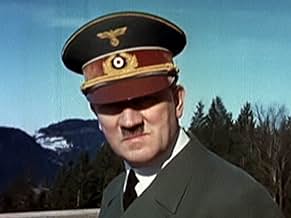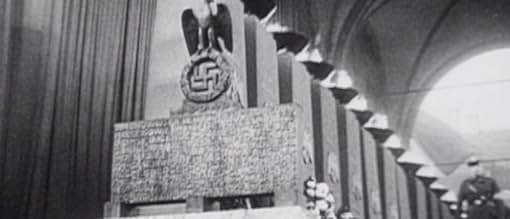The Nazification of Germany from 1933 to 1945 told through a compilation of Nazi footage, newsreels, propaganda films and Eva Braun's home movies.The Nazification of Germany from 1933 to 1945 told through a compilation of Nazi footage, newsreels, propaganda films and Eva Braun's home movies.The Nazification of Germany from 1933 to 1945 told through a compilation of Nazi footage, newsreels, propaganda films and Eva Braun's home movies.
Galeazzo Ciano
- Self
- (archive footage)
Albert Einstein
- Self
- (archive footage)
Joseph Goebbels
- Self
- (archive footage)
- (as Josef Goebbels)
Hermann Göring
- Self
- (archive footage)
Heinrich Himmler
- Self
- (archive footage)
Adolf Hitler
- Self
- (archive footage)
Benito Mussolini
- Self
- (archive footage)
Jesse Owens
- Self
- (archive footage)
Joachim von Ribbentrop
- Self
- (archive footage)
- Director
- Writers
- All cast & crew
- Production, box office & more at IMDbPro
Featured reviews
This film consists entirely of footage taken during the Third Reich, without the usual background comment. Some is official and mostly in B&W; speeches by Hitler and his henchmen, Nazi celebrations and rituals, the 1936 Olympics, ordinary Germans going into ecstasies over the view of the Führer, exhibitions of awful Nazi "art" and so on. The rest is mainly in color, home movies taken by Eva Braun and others (using an 8mm camera gifted by Hitler) featuring members of Hitler's inner circle plus assorted visitors in his Obersalzberg mountain retreat and environs. I believe this latter footage was made public by the first time in this film, which was shown at the Cannes festival in 1973.
The movie's purpose is clearly stated on the first screen: "If the human features of Hitler are lacking in the image of him that is passed on to posterity, if he is dehumanized and shown only as a devil, any future Hitler may not be recognized simply because he is a human being." Indeed Hitler was not an abstraction like a "devil" or "monster," but a human being, albeit one capable of almost inconceivable levels of evil. This take on Nazism was controversial, aroused violent responses at Cannes and the film was banned for many years in Israel and Germany. Since then, the home movie footage has been featured in many documentaries and is available in You Tube.
The last shots are of German cities razed to the ground and one particularly horrifying sequence filmed in the recently liberated Belsen concentration camp, with Noel Coward's wartime satyrical song "Don't let's be beastly to the Germans" as background music.
In some of the home movies shown, snatches of dialogue (mostly unintelligible) are heard. Since the original footage was soundless, the dialogues were reconstructed. We don't know how or from what sources. Much later (in 2006) the conversations were almost entirely restored using sophisticated lip reading software. This footage can be seen in Hitler's Private World, a 2006 episode of the British TV series Revealed.
The movie's purpose is clearly stated on the first screen: "If the human features of Hitler are lacking in the image of him that is passed on to posterity, if he is dehumanized and shown only as a devil, any future Hitler may not be recognized simply because he is a human being." Indeed Hitler was not an abstraction like a "devil" or "monster," but a human being, albeit one capable of almost inconceivable levels of evil. This take on Nazism was controversial, aroused violent responses at Cannes and the film was banned for many years in Israel and Germany. Since then, the home movie footage has been featured in many documentaries and is available in You Tube.
The last shots are of German cities razed to the ground and one particularly horrifying sequence filmed in the recently liberated Belsen concentration camp, with Noel Coward's wartime satyrical song "Don't let's be beastly to the Germans" as background music.
In some of the home movies shown, snatches of dialogue (mostly unintelligible) are heard. Since the original footage was soundless, the dialogues were reconstructed. We don't know how or from what sources. Much later (in 2006) the conversations were almost entirely restored using sophisticated lip reading software. This footage can be seen in Hitler's Private World, a 2006 episode of the British TV series Revealed.
Seeing this doc without a word from anyone, l'd realized a bit awkward, how l love documentaries, this one was an too unusual, all those old footages from the Third Reich in every places, endless speechs by the Fuher, all those political meetings, whatever happens l'll see it until to the end, and it arrives in worst ways, all those death bodies buried by tractors, all cities bombed and were quite often destroyed almost entirely, all those people trying running away from the soldiers or by buildings collapsed by fire, well l'd though poor german people who were compelled to believe in a such mad men, who ruled by force, all those barbarism ends up in a true massacre of sixty millions people in all Europe, Africa and Asia, that is serves as example forever, sorry for the last song mocking for german people, fully unnecessary, this war nobody won!!!
Resume:
First watch: 2019 / How many: 1 / Source: DVD / Rating: 7.5
Resume:
First watch: 2019 / How many: 1 / Source: DVD / Rating: 7.5
Because this documentary is centered on a place almost universally reviled by everyone on Earth, it was surprising to see it start off with quite a controversial statement. The opening slide states that if future historians demonize Hitler because of what he did, they're going to miss the entire point of the film, as it shows (largely through his eyes) what he really was: a human. This film, while basically just a large assortment of newsreels and footage from prewar Nazi Germany, surprised me more than a few times. With the Second World War being the historical subject I devote the most time to learning about, I wasn't expecting this movie to contain things I have never seen before. Most will be familiar with things like the huge rally in Nuremberg, as well as Neville Chamberlain professing to the British public Hitler won't fight England just because he signed a meaningless agreement. However, there's also scenes of propaganda minister Dr. Goebbels visiting Hitler at his mountain house in southern Bavaria. These types of clips tend to humanize Hitler and make him seem almost normal, which is probably why most people haven't seen them. I really did not expect to see Eva Braun saying how handsome she thinks Clark Gable is either. Her home movies taken at the Obersalzberg have been in countless ww2 documentaries, including what is probably the best one ever (World at War), but they never fail to be eerie to watch. We see her and her sister Gretl swim in a river, and later, she brings her scottish terriers to Hitler's house. Adolf reportedly didn't like Eva's dogs because they bit Blondi, his german shepherd. Ironically, one of her dogs was named Stasi, which would be the name of the postwar secret police in communist east germany. Another thing that caught my attention was taking a look inside the Reich Chancellery, which was the building Hitler commanded germany from. Aside from his office, pretty much the whole entire interior of the building looks like a 5 star hotel. Also shown is an art museum containing the works of National Socialist painters and sculptors, both trying their hardest to capture the perfect likeness of the Nordic race. One of Mussolini's in-laws is present at the opening ceremony. The statues in the museum are quite impressive, given that they were made in the 30s. One consisting of a man and his horse makes even Michaelangelo's David look tiny. The film includes some things that aren't really related to nazism, but were thrown in anyway simply because they occurred in germany. One of these is Einstein talking to an audience after he has learned the nazis want him out of germany. It never crossed my mind, but I think this is the first time I heard him talk. The documentary doesn't go into world war 2 itself, and only focuses on the period from 1933 to 39, but does jump ahead to 1945 at the end. This means it's nowhere near as comprehensive as something like World at War, which not only includes much of the same footage but also includes interviews with people who were within 5 feet of Hitler for much of his time as chancellor. While the footage of the 1936 Olympics, home movies and other things are enough to make the film passable in my eyes, it is hampered by a lack of substance to stand on. The footage is the only thing here telling the story. As a consequence, this will probably only please avid fans of this type of history, but it wasn't a problem for me. There's definitely a lot of things I never saw before, so it's excusable.
I tripped over this movie late at night on Amazon on-demand video. I gotta tell you, it's definitely interesting. It shows the "human" side of Hitler, joking around with staff, making wise cracks here and there, complaining about cigarette smoke, etc. I think the intent of the story (which is basically newsreel and personal movie camera footage in order from 1935 to 1945) is to chronicle the rise and fall of Hitler, as seen in his eyes. You can see how the war wears on him- he gets grayer, starts shaking at times, and even see how he can't stand being in direct sunlight because of the drugs he was on. So, knowing his personal and physical history from what I've read before about the sick Bastard, this movie confirms those conclusions (i.e.- he was mentally ill and took large doses of drugs that blurred his speech, the way he walked, the way he interacted with others, etc. So, it's a good documentary from that end. Suggest watching with the volume down most of the time because hearing all the "Hiel Hitler!"s are enough to make you want to drink...
10joel-28
Philippe Mora was the person who as a 19 year old film student discovered the now well known personal films of Eva Braun (that would make a fine film in itself). This fascinating color film footage is incorporated into this un narrated documentary along with a wide assortment of original Nazi newsreels and propaganda films to present life in Nazi Germany from 1933-45 as seen through the propaganda filmmakers (and Eva's) camera lens. A wonderful classical music score accompanies. This film is quite rare and is generally unavailable. I believe it was nominated for an award (or won an award). Nevertheless,if you get a chance to see it, buy it, etc, do it. It is the best documentary film on Nazi Germany of it's kind with much never before seen original footage.
Did you know
- TriviaThe provocative documentary was banned in Israel on the ground that it projects a sympathetic image of Adolf Hitler.
- ConnectionsFeatured in Swastika Revisited (2006)
- How long is Swastika?Powered by Alexa
Details
- Release date
- Country of origin
- Official site
- Language
- Also known as
- Swastika - hakkorset
- Production company
- See more company credits at IMDbPro
- Runtime
- 1h 53m(113 min)
- Color
- Sound mix
Contribute to this page
Suggest an edit or add missing content



























